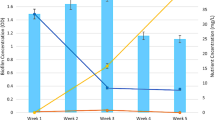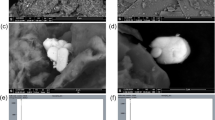Abstract
The aim of the present research was to study the biofilms developed in a Spanish nuclear power plant and their ability to entrap radionuclides. In order to carry this out, a bioreactor, which was then submerged in a spent nuclear fuel pool, was designed. To characterise the biofilm on two different metallic materials (stainless steel and titanium), standard culture microbiological methods and molecular biology tools, as well as epifluorescence and scanning electron microscopy were used. The bacterial composition of the biofilm belongs to several phylogenetic groups (α, β, and γ-Proteobacteria, Actinobacteridae, and Firmicutes). The radioactivity of the biofilms was measured by gamma-ray spectrometry. Biofilms were able to retain radionuclides from radioactive water, especially 60Co. The potential use of these biofilms in bioremediation of radioactive water is discussed.








Similar content being viewed by others
References
AWWA-APHA-WEF (1998) In: Clescerl LS, Greenberg AE, Eaton AD (eds) Standard methods for the examination of water and wastewater, 20th edn. American Public Health Association, Washington DC
Andreoni V, Cavalca L, Rao MA, Nocerino G, Bernasconi S, Dell’Amico E, Colombo M, Gianfreda L (2004) Bacterial communities and enzyme activities of PAHs polluted soils. Chemosphere 57:401–412
Bourquin AW, Mosteller DC, Olsen RL, Smith MJ, Reardon KF (1997) Aerobic bioremediation of TCE-contaminated groundwater: bioaugmentation with Burkholderia cepacia PR1301. In: In situ and on-site bioremediation symposium, vol 4. Battelle Press, Columbus, pp 513–518
Chicote E, García AM, Moreno DA, Sarró MI, Lorenzo PI, Montero F (2005) Isolation and identification of bacteria from spent nuclear fuel pools. J Ind Microbiol Biotechnol 32:155–162
Chicote E, Moreno DA, García AM, Sarró MI, Lorenzo PI, Montero F (2004) Biofouling of the walls of a spent nuclear fuel pool with radioactive ultrapure water. Biofouling 20:35–42
Choppin GR (1992) The role of natural organics in radionuclide migration in natural aquifer system. Radiochim Acta 58/59:113–120
Council Directive 96/29/EURATOM of 13 May 1996. Laying down basic safety standards for the protection of the health of workers and the general public against the dangers arising from ionizing radiation. Official Journal L 159, 29/06/1996, pp 0001–0114
Debertin K, Helmer RG (1998) Gamma-ray and X-ray spectrometry with semiconductor detectors. North-Holland, Amsterdam, pp 258–281
Esteve-Núñez A, Caballero A, Ramos JL (2001) Biological degradation of 2,4,6-trinitrotoluene. Microbiol Mol Biol Rev 65:335–352
Gadd GM (2000) Bioremedial potential of microbial mechanisms of metal mobilization and immobilization. Curr Opin Biotechnol 11:271–279
Gazsó LG (1997) Basic radiation microbiology. In: Wolfram JH, Rogers RD, Gazsó LG (eds) Microbial degradation processes in radioactive waste repository and in nuclear fuel storage areas, vol 11. Kluwer Academic Publishers Group, NATO ASI Series 1, Disarmament Technologies, pp 93–101
Governal RA, Yahya MT, Gerba CP, Shadman F (1991) Oligothrophic bacteria in ultra-pure water systems: media selection and process component evaluations. J Ind Microbiol Biotechnol 8:223–227
Jacobsen CS (1997) Plant protection and rhizosphere colonization of barley by seed inoculated herbicide degrading Burkholderia (Pseudomonas) cepacia DBO1 (pRO101) in 2,4-d contaminated soil. Plant Soil 189:139–144
Jukes TH, Cantor CR (1969) Evolution of protein molecules. In: Munro HN (ed) Mammalian protein metabolism. Academic, New York, pp 21–132
Knapp RB, Faison BD (1997) A bioengineering system for in situ bioremediation of contaminated groundwater. J Ind Microbiol Biotechnol 18:189–197
Kulakov LA, McAlister MB, Ogden KL, Larkin MJ, O’Hanlon JF (2002) Analysis of bacteria contaminating ultrapure water in industrial systems. Appl Environ Microbiol 68:1548–1555
Kumar S, Tamura K, Jakobsen IB, Nei M (2001) MEGA2: molecular evolutionary genetics analysis software. Bioinformatics 17:1244–1245
Lloyd JR, Macaskie LE (2000) Bioremediation of radionuclide-containing wastewaters. In: Lovley DR (ed) Environmental microbe-metal interactions. ASM Press, Washington, pp 277–327
Lovley DR, Lloyd JR (2000) Microbes with a mettle for bioremediation. Nat Biotechnol 18:600–601
McAlister MB, Kulakov LA, O’Hanlon JF, Larkin MJ, Ogden KL (2002) Survival and nutritional requirements of three bacteria isolated from ultrapure water. J Ind Microbiol Biotechnol 29:75–82
Mueller JG, Devereux R, Santavy DL, Lantz SE, Willis SG, Pritchard PH (1997) Phylogenetic and physiological comparisons of PAH-degrading bacteria from geographically diverse soils. Anton Leeuw 71:329–343
Santo Domingo JW, Berry CJ, Summer M, Fliermans CB (1998) Microbiology of spent nuclear fuel storage basins. Curr Microbiol 37:387–394
Sar P, Kazy SK, D’Souza SF (2004) Radionuclide remediation using a bacterial biosorbent. Int Biodeter Biodegr 54:193–202
Sarró MI, Moreno DA, Chicote E, Lorenzo PI, García AM, Montero F (2003) Biofouling on austenitic stainless steels in spent nuclear fuel pools. Mater Corros 54:535–540
Selenska-Pobell S, Panak P, Miteva V, Boudakov I, Bernhard G, Nitsche H (1999) Selective accumulation of heavy metals by three indigenous Bacillus strains, B. cereus, B. megaterium and B. sphaericus from drain waters of a uranium waste pile. FEMS Microbiol Ecol 29:59–67
Thompson JD, Gibson TJ, Plewniak F, Jeanmougin F, Higgins DG (1997) The CLUSTAL_X windows interface: flexible strategies for multiple sequence alignment aided by quality analysis tools. Nucleic Acids Res 25:4876–4882
Valentine NB, Bolton H Jr, Kingsley MT, Drake GR, Balkwill DL, Plymale AE (1995) Biosorption of cadmium, cobalt, nickel, and strontium by a Bacillus simplex strain isolated from the vadose zone. J Ind Microbiol Biotechnol 16:189–196
Venkateswaran K, Kempf M, Chen F, Satomi M, Nicholson W, Kern R (2003) Bacillus nealsonii sp. nov., isolated from a spacecraft-assembly facility, whose spores are gamma-radiation resistant. Int J Syst Evol Microbiol 53:165–172
Wolfram, JH, Dirk WJ (1997) Biofilm development and the survival of microorganisms in water systems of nuclear reactors and spent fuel pools. In: Wolfram JH, Rogers RD, Gazsó LG (eds) Microbial degradation processes in radioactive waste repository and in nuclear fuel storage areas, vol 11. Kluwer Academic Publishers Group, NATO ASI Series 1, Disarmament Technologies, pp 139–147
Acknowledgment
We are grateful to the Spanish Ministry of Science and Technology (Ministerio de Ciencia y Tecnología, CICYT-FEDER-2FD97-0530-MAT) and Iberdrola Generación, S.A. (6276-99) for their financial support. M. Isabel Sarró is very grateful to the Technical University of Madrid (UPM) and to the Madrid Community (Comunidad de Madrid) for receiving a grant so as to be able to do her Doctoral thesis. We would like to thank Juan de Dios Sánchez, Gabriel Mora and José Antonio Pérez Molina (NPP Cofrentes, Valencia, Spain) for their help, technical assistance, and sample processing at the nuclear power plant.
Author information
Authors and Affiliations
Corresponding author
Rights and permissions
About this article
Cite this article
Sarró, M.I., García, A.M., Moreno, D.A. et al. Development and characterization of biofilms on stainless steel and titanium in spent nuclear fuel pools. J Ind Microbiol Biotechnol 34, 433–441 (2007). https://doi.org/10.1007/s10295-007-0215-7
Received:
Accepted:
Published:
Issue Date:
DOI: https://doi.org/10.1007/s10295-007-0215-7




